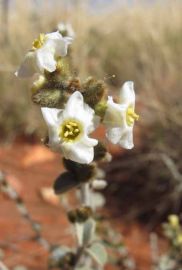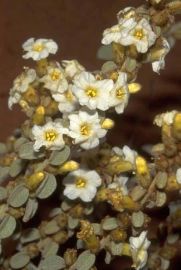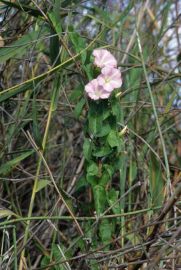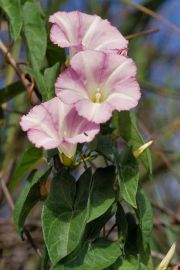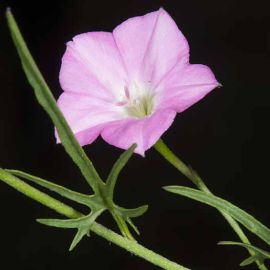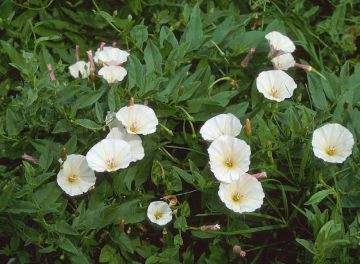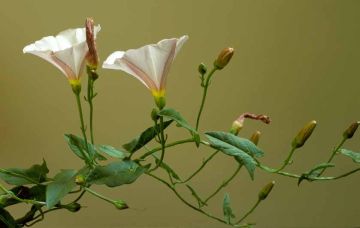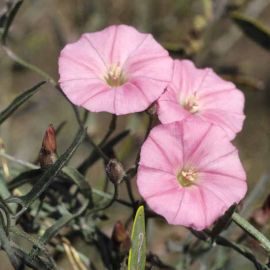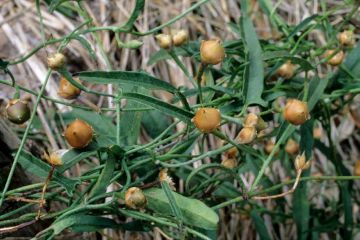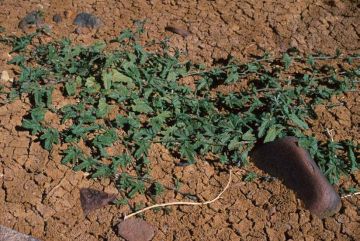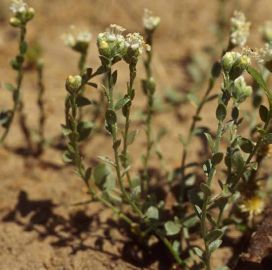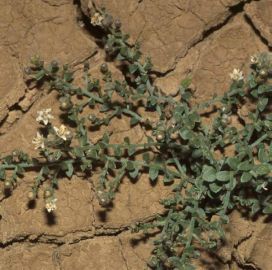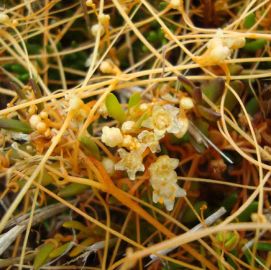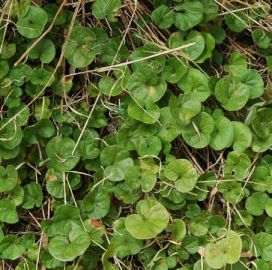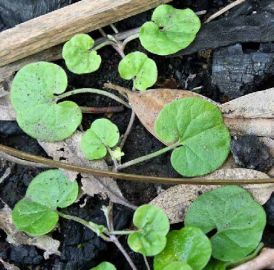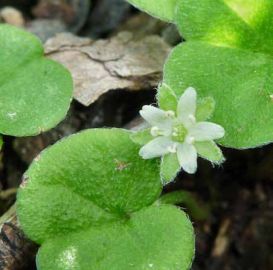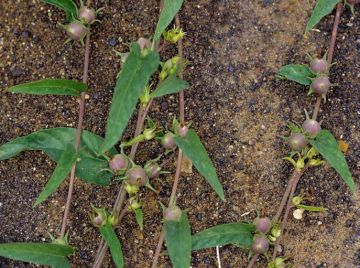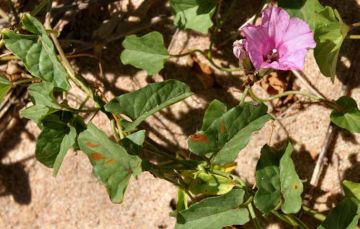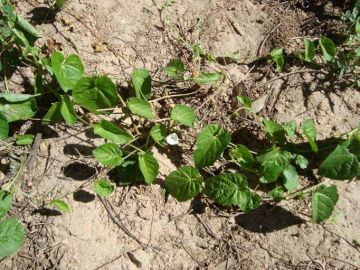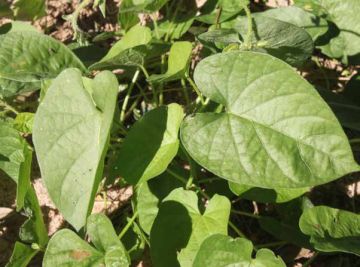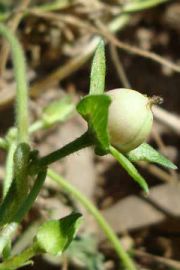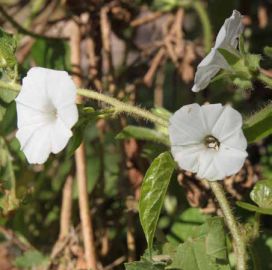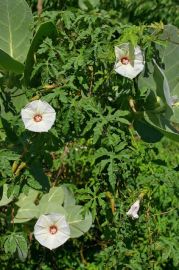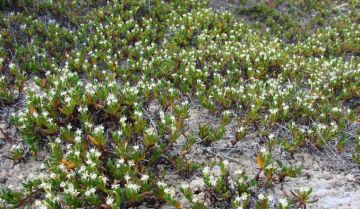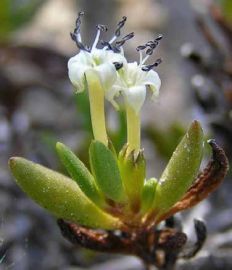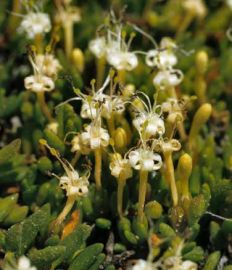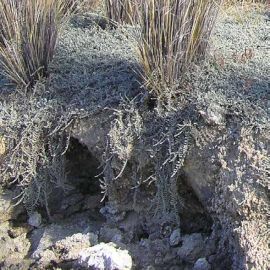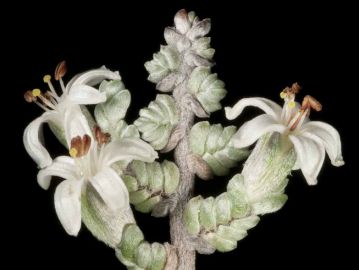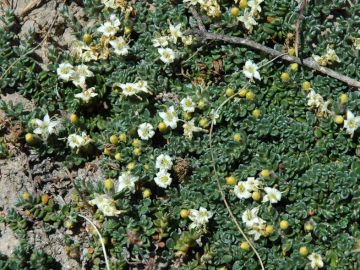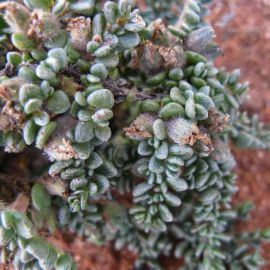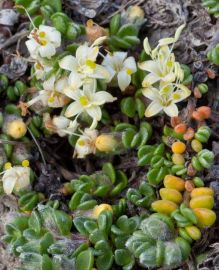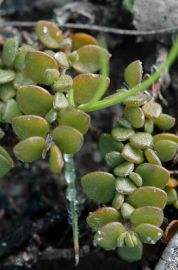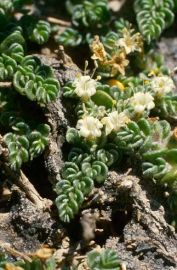R.W. Johnson, updated by P.J. Lang & R.M. Barker
Annual or perennial herbs or shrubs, often with trailing or twining stems, or leafless parasites; leaves alternate, exstipulate. Inflorescence axillary, rarely terminal, cymose or reduced to a single flower; flowers regular, (4) 5 (6)-merous, bisexual; sepals free or rarely united, quincuncial; corolla sympetalous, funnel-shaped or campanulate, occasionally rotate or salver-shaped; stamens adnate to the base of the corolla, alternating with the corolla lobes, filaments usually flattened and dilated downwards; anthers 2-celled, dehiscing longitudinally; ovary superior, mostly 2-celled, occasionally with 1, 3 or 4 cells, subtended by a disk; ovules 2, rarely 1, in each cell; styles 1 or 2, stigmas variously shaped. Fruit capsular.
About 58 genera and 1,650 species mainly tropical and subtropical; in Australia 20 genera, 1 endemic, with c. 160 species, 17 naturalised.
The highly modified parasitic species of Cuscuta are sometimes placed in a separate family, the Cuscutaceae.
1. Yellowish leafless parasitic twiners
1: Green leafy plants
2. Ovary distinctly 2-
lobed;
styles 2, inserted between the
lobes of
ovary (gynobasic
style); leaves often kidney-shaped
2: Ovary entire; style or styles terminal
3. Sepals
connate, with
lobes shorter than the tube
3: Sepals free
4. Styles 2, free or united for up to half their length; hairs 2-branched
5. Styles united at the base
5: Styles free
6. Styles forked, with
linear stigmas
6: Styles
entire, with
capitate stigmas
4: Style 1; hairs not 2-branched
7. Stigma entire, capitate or biglobular
8. Pollen smooth; in S.A. leaves palmately divided almost to the base,
lobes dentate to
lobed, hirsute
8: Pollen spinulose; leaves otherwise, if palmately divided then
lobes entire,
glabrous
7: Stigma 2-lobed, linear to oblong
9. Bracteoles large, enclosing the
calyx
9: Bracteoles small, distant from the
calyx
Breweria R.Br., Prodr. 487 (1810).
(After Francois Bonami, 1710–1786, a French physician and botanist.)
Hist. Vég. lles France 33, t. 8 (1804), nom. cons..
Perennial subshrubs or vines with trailing stems; hairs 2-branched; leaves entire. Inflorescence axillary, flowers solitary or cymose, bracteolate; sepals 5, free; corolla funnel-shaped or campanulate, entire to shallowly 5-lobed, folded in the bud, mid-petaline band hairy on the outside; stamens 5, included, glabrous or sparsely hairy at the base; pollen smooth; ovary glabrous or pilose, 2-celled with 2 ovules per cell; styles 2, united in the lower half, each with a globose or capitate stigma. Capsule ovoid-conical, dehiscing longitudinally into 4–8 valves; seeds 2–4, glabrous or pilose.
Pantropical and subtropical genus of c. 50 species, 19 endemic to Australia.
Reference: Myint (1968), Myint & Ward (1968).
1. Shrubs with stiffly erect and
ascending stems; leaves
orbicular to
oblong-
elliptic, length:width ratio 1–1.5
1: Herbs with trailing stems; leaves ovate to oblong, length:width ratio >1.5
2. Leaf blades
ovate, usually > 5 mm wide, length:width ratio < 2.5
2: Leaf blades
oblong to
ovate-
oblong, usually ≤ 5 mm wide, length:width ratio > 2.5
Herbaceous perennial with trailing stems or low subshrub; leaves petiolate, petiole 1–4 mm long, blade oblong to ovate-oblong, 10–25 mm × 2.5–6 mm, with a length:width ratio of 2.5–6, base and apex obtuse to rounded. Inflorescence axillary, cymose; peduncle ± absent, bearing 1–2 flowers; bracteoles 1–2 mm long; pedicels 2–5 mm long; outer sepals ovate, acute, 4.5–6.5 mm long, inner sepals shorter and acuminate; corolla funnel-shaped, white, 5–7 mm long, 8–10 mm diam., with hairy mid-petaline bands; stamens adnate to the base of the corolla for 1.5–2.5 mm, filaments free for 3.5–5 mm, occasional tubercles to short hairs about the point of attachment; ovary pilose in the upper half; styles of unequal length; stigmas capitate. Capsule conical, pilose at the apex, about as long as the sepals.
S.A.: LE; N.T. Grows on plains and in dunal areas on deep red sands and grey silty loams with scattered eucalypts and acacias. Flowers: Mar.–Sep.
Only known by a single collection from the Bloodwood Bore area near the Qld/S.A. border. This population is an outlier of the main population found in the Tanami Desert, N.T.
Shrub with erect and ascending stems to 60 cm; leaves ± sessile to shortly petiolate, orbicular to oblong-elliptic, 5–15 × 3–11 mm, with a length:width ratio of 1–1.5, obtuse to rounded, mucronulate, base rounded. Inflorescence axillary, cymose; peduncle ± absent, bearing 1, occasionally 2–3 flowers; bracteoles 2–3 mm long; pedicels to 2 mm long; outer sepals ovate to ovate-lanceolate, acute, 5–8 mm long, inner sepals slightly shorter and more acuminate; corolla funnel-shaped, white, 8–10 mm long, 10–12 mm diam., with sericeous mid-petaline bands; stamens adnate to the base of the corolla for 3–4 mm, filaments free for 3.5–5 mm, hairy on the fused basal part; ovary pilose in the upper half; styles of unequal length; stigmas capitate. Capsule conical, pilose at the apex, shorter than the sepals.
S.A:, NW; W.A.; N.T. Grows in hummock grassland (Triodia pungens), often with an overstorey of Acacia spp. and Allocasuarina decaisneana on red and yellow sand plains and dunes. Flowers: May–Nov.
Plate 1A, 1B
Photos: A, Nathan Johnson; B–D, A.C. Robinson, DEWNR; E & F, P.J. Lang, DEWNR; G, C.M. Chesson.
A, Calystegia sepium, Rawlinson Ranges, W.A.
B, Calystegia sepium, northeast of Pipalyatjara, NW
Herbaceous perennial with trailing stems; leaves petiolate, petiole 2–7 mm long, blade ovate, ovate-lanceolate to ovate-oblong 10–25 × 5–15 mm, with a length:width ratio of 1.5–2, obtuse, occasionally apiculate, mucronulate, base obtuse to subcordate. Inflorescence axillary, cymose; peduncle ± absent, bearing 1–3 flowers; bracteoles 1–3 mm long; pedicels 1–5 mm long; outer sepals ovate to ovate-lanceolate or ovate-elliptic, acute, 4.5–7 mm long, inner sepals slightly shorter and slightly acuminate; corolla funnel-shaped, white, 8–12 mm long, 6–10 mm diam., with hairy mid-petaline bands; stamens adnate to the base of the corolla for c. 2 mm; filaments free for 4–5.5 mm, hairy above and below the point of attachment; ovary pilose in the upper half; styles subequal to unequal; stigmas capitate. Capsule conical, pilose at the apex, shorter than the sepals.
S.A.: LE; W.A.; N.T.; Qld; N.S.W. Only known by 3 collections from the Innamincka area. Grows in eucalypt woodlands in red and yellow sands and sandy loams, and on clay flats in dune swale. Flowers: throughout the year, mainly Sep.–May.
(Greek kalyx, calyx; stege, a covering; referring to the 2 large bracteoles enclosing the calyx.)
Prodr. 483 (1810), nom. cons.
Perennial vines with trailing or twining stems, ± glabrous; leaves entire, often sagittate or hastate. Inflorescence axillary; flowers usually solitary; bracteoles large and enclosing the calyx; sepals 5, free; corolla campanulate to funnel-shaped, entire to slightly 5-lobed, mid-petaline bands distinct, glabrous; stamens 5, included; filaments subequal; pollen smooth; ovary glabrous, 1-celled or imperfectly 2-celled, with 4 ovules; style 1, with 2 oblong or elliptic stigmas. Capsule globular to ovoid, dehiscing longitudinally into 4 valves; seeds 4, glabrous.
About 25 species mainly temperate; 3 native to and 1 naturalised in Australia.
1. Bracteoles to 15 mm wide,
acute
1: Bracteoles > 15 mm wide, rounded to
emarginate
Glabrous, occasionally very sparsely hairy, perennial with twining stems; leaves ovate to lanceolate, 4–10 × 1.5–8 cm, acuminate, acute, sagittate or slightly hastate. Inflorescence axillary; peduncles 2–8 cm long, bearing 1 flower; bracteoles opposite, ovate, acute, 15–25 × 8–12 mm, enclosing the sepals; sepals subequal, ovate-lanceolate, 12–15 mm long, corolla funnel-shaped, with a broad tube, pale pink occasionally white, 4–6 cm long; stamens adnate to the base of the corolla for 7–9 mm; filaments ± equal, free for 10–15 mm long, hairy above and below the point of attachment; ovary incompletely 2-celled; style 20–25 mm long; stigmatic lobes oblong. Capsule ovoid to subglobose, 7–8 mm high; seeds 4–5 mm long, black. Large bindweed, greater bindweed.
S.A.: MU, SL, SE; W.A.; N.S.W.; Vic.; Tas. The species has an almost cosmopolitan distribution. It grows in damp places, often on river banks. Flowers: Nov.–May.
Calystegia sepium is a widespread and highly polymorphic species with a number of subspecies recognized. Brummitt (1967) studied the S.A. specimens of C. sepium and concluded they belong to C. sepium subsp. roseata Brummitt. However based on his key to Calystegia in Flora Europaea (Brummitt 1972), the pale pink, occasionally white, flowers, rather than bright pink, ± glabrous foliage and often shortly acute leaf apex, suggest they are better placed in C. sepium subsp. sepium.
Plate 1C, 1D
Photos: A, Nathan Johnson; B–D, A.C. Robinson, DEWNR; E & F, P.J. Lang, DEWNR; G, C.M. Chesson.
C, Calystegia sepium, Mud Islands G.R., SL, BS136-315
D, Calystegia sepium, Mud Islands G.R., SL, BS136-315
2.2
*
Calystegia silvatica subsp.
silvaticaGlabrous perennial with twining stems; leaves ovate to broadly ovate, 5–10 × 5–10 cm, acute to narrowly obtuse, finely mucronulate, cordate and shallowly lobed at the base. Inflorescence axillary; peduncles 8–20 (–30) cm long, bearing 1 flower; bracteoles opposite, broadly ovate, rounded truncate or emarginate, 20–35 × 18–40 mm, enclosing the sepals; sepals subequal, ovate-lanceolate, 15–20 mm long, corolla funnel-shaped, white or tinged with pink, 4–7 cm long; stamens adnate to the base of the corolla for 6–7 mm; filaments ± equal, free for 10–15 mm, hairy above and below the point of attachment; ovary incompletely 2-celled; style 17–23 mm long; stigmatic lobes oblong. Capsule ovoid to subglobose, 10–12 mm high; seeds 4–5 mm long, black. Greater bindweed.
S.A.: *SL, *KI, *SE; *N.S.W.; *Vic.; *Tas. Native of southern Europe. It has escaped from cultivation and now grows in disturbed waste ground of urban and agricultural lands and along transport corridors. Flowers: Oct.–Apr.
(Latin convolvere, to roll together or entwine; referring to its twining habit.)
Sp. Pl. 1: 153 (1753).
Perennials (rarely annuals), with trailing or twining stems, rarely erect, glabrous or with simple hairs; leaves entire to deeply lobed, often hastate or sagittate. Inflorescence axillary, cymose, with 1 to few flowers or rarely in dense heads, bracteolate; sepals 5, free; corolla funnel-shaped, entire to slightly 5-lobed, mid-petaline bands hairy, rarely glabrous; stamens 5, included, adnate to the base of the corolla, often tuberculate at the base; pollen smooth; ovary 2-celled with 2 ovules per cell; style 1, with 2 linear, cylindric stigmas. Capsule globular to globular-ovoid, with a persistent style base, dehiscing longitudinally into 4 valves or opening irregularly; seeds usually 4, often verrucose, usually glabrous. Bindweeds.
Mainly temperate and subtropical genus of c. 250 species, 11 endemic and 1 naturalised in Australia.
Reference: Johnson (2001).
1. Leaves hastate or sagittate, with an entire terminal lobe and a pair of entire or occasionally 2-toothed or divided basal lobes
2. Sepals mostly ≤ 4 mm long, apex rounded to truncate, emarginate
3. Corolla 15–30 mm long;
sepals 3–4 mm long; leaves
glabrous or with
scattered ±
spreading hairs
3: Corolla 5–10 mm long;
sepals usually < 3 mm long; leaves moderately to sparsely hairy with
appressed hairs
2: Sepals 4–7 mm long, rarely shorter, apex acute to rounded, apiculate
4. Sepals and leaves with
spreading hairs;
inflorescence 1-flowered;
pedicels at fruiting
recurved;
wings on
seeds not prominent, absent to discontinuous
4: Sepals and leaves with ±
appressed hairs;
inflorescence 1–3-flowered;
pedicels at fruiting straight or
sinuate;
wings on
seeds narrow, ± continuous
1: Leaves crenate, serrate to shallowly lobed or if a distinct terminal lobe is present then basal lobes auriculate and toothed or much divided with ascending lobes prominent
5. Leaves crenate or serrate; basal lobes usually not prominent, sericeous
6. Peduncles at flowering < 12 mm long;
seeds < 3 mm long;
capsules < 4.5 mm in diameter
6: Peduncles at flowering mainly > 12 mm long;
seeds > 3 mm long;
capsules 5–6 mm in diameter
5: Leaves with distinct terminal lobe and much divided prominent basal lobes or basal lobes auriculate and toothed, not sericeous
7. Pedicels at fruiting recurved
8. Corolla > 9 mm long;
sepals sparsely to moderately hairy,
pedicels 3–23 mm long;
seeds 3–4 mm long
8: Corolla ≤ 9 mm long;
sepals moderately to densely hairy,
pedicels 2–6 mm long;
seeds 2.5–3.2 mm long
7: Pedicels at fruiting ± straight to sinuate
9. Stems slender;
seeds 2.5–3.2 mm long, with
wing present, often discontinuous
9: Stems coarse;
seeds 3.5–4 mm long with no obvious
wing
3.1
Convolvulus angustissimus Stems trailing and twining; leaves very variable in shape, basal leaves ovate to oblong, soon becoming lobed, upper cauline leaves narrowly ovate to ovate in outline, 10–65 mm long, acute to rounded, emarginate, base hastate to deeply 3–5-lobed, lobes spreading to recurved, 2-toothed, ascending lobes less than half the length of the terminal lobe, terminal lobe narrowly linear to narrowly oblong, entire to slightly lobed, moderately hairy to ± glabrous. Inflorescence cymose, 1-, rarely 2-flowered; peduncle 4–50 mm long; pedicel 3–23 mm long, recurved at fruiting; outer sepals obovate to elliptic, acute to rounded with a short reflexed apiculum, 4–6.5 mm long, glabrous to moderately hairy with erect to appressed hairs, inner sepals similar; corolla pink, with a paler throat, rarely white, 7–20 mm long; filaments adnate at base for 1.5–3 mm, free for 1.75–5 mm; style 3–10 mm long. Capsule globular to globular ovoid, 4–7.5 mm diam.; seeds black or dark-brown, usually verrucose, 3–4 mm long. Australian bindweed, pink bindweed.
1. Lower
cauline leaves broad and much divided;
lobes gradually becoming narrower towards the tip; terminal
lobe > 1.5 mm wide
1: Lower cauline leaves with narrow lobes almost from the base; terminal lobe < 1.5 mm wide, if greater then basal lobes spreading and clavate and terminal lobe distinctly obovate-clavate
2. Leaves with
ascending lobes, mostly < 1/3 the length of the terminal
lobe; lower
cauline leaves with
distinct spreading clavate basal
lobes;
sepals moderately to sparsely hairy with
ascending and
spreading hairs common
2: Leaves with
ascending lobes, often > 1/3 the length of the terminal
lobe and lacking
distinct basal
lobes;
sepals glabrous to sparsely hairy, with the hairs mainly
appressed
3.1a
Convolvulus angustissimus subsp.
angustissimus Lower cauline leaves with blade ovate to oblong, sometimes triangular or linear, margins irregularly crenate to serrate to shallowly lobed with basal and ascending lobes barely prominent; upper leaves becoming distinctly lobed with terminal lobe > 1.5 mm wide. Pedicels 3–23 mm long; outer sepals moderately to sparsely hairy, hairs loosely ascending to spreading, some appressed, or more rarely almost all appressed; corolla 9–21 mm long. Seed surface with low reticulate ± continuous ridges.
S.A.: FR, EP, NL, MU, YP, SL, SE; W.A.; Qld; N.S.W.; Vic.; Tas. Grows on level to hilly terrain in mainly loamy and clay soils, less commonly in sandy and rocky soils, in grassy eucalypt woodland and forest and in grassland following clearing. Flowers: throughout the year, mainly Sep.–Apr.
Plate 1G
Photos: A, Nathan Johnson; B–D, A.C. Robinson, DEWNR; E & F, P.J. Lang, DEWNR; G, C.M. Chesson.
G, Convolvulus angustissimus subsp. angustissimus, Cromer C.P., SL
3.1b
Convolvulus angustissimus subsp.
fililobus Lower cauline leaves linear, linear-elliptic to narrowly oblong, hastate, margins undulate, often toothed or lobed towards base, base tapering to truncate, apex obtuse to rounded; upper leaves deeply 5-lobed with terminal lobe < 1.5 mm wide. Pedicels 4–8 mm long; outer sepals sparsely (very rarely moderately) hairy to glabrous, hairs mainly appressed; corolla 9–14 mm long. Seed surface finely punctuate without any protuberances and a distinct ridge on outer margin.
S.A.: ?idSE; N.S.W.; Vic. Known only from a collection near Padthaway. Grows on clay and clay-loam soils on plains. Flowers: Dec. (1 collection), mainly Sep.–Dec. (other states).
There is a scattering of material from the SE region towards the Vic. border with smooth seeds (characteristic of subsp. fililobus), but leaf morphology (and sometimes sepal indumentum) intermediate with subsp. peninsularum. Two specimens from the Mt Lofty Ranges were annotated by Johnson in 2001 as having leaf morphology matching subsp. fililobus, but with reticulate (not smooth) sculpturing of the seeds. The distinctive typical subsp peninsularum with obvious spreading basal lobes is largely confined to southern EP and YP.
3.1c
Convolvulus angustissimus subsp.
peninsularum Lower cauline leaves deeply lobed at base, basal pair of lobes linear to obovate, lateral to recurved, often with a recurved secondary lobe from the lower margin, ascending and terminal lobes distinct, linear; upper leaves with very narrow lobes, terminal lobe < 1.5 mm wide. Pedicels 3–8 mm long; outer sepals moderately to sparsely hairy with appressed, ascending to spreading hairs; corolla 8–13 mm long. Seed surface with sparse low reticulate ridges.
S.A.: FR, EA, EP, NL, MU, YP, SL, KI, SE. Grows on seashores and coastal cliffs and extends inland, mainly in heathlands and grasslands. Flowers: Nov.–Feb.
This subspecies includes distinctive variants which occur in coastal areas mainly in the southern parts of the Yorke and Eyre Peninsulas. Without complete material it is difficult to distinguish from smaller flowered forms of C. angustissimus subsp. angustissimus which occur to the north. Some plants from the Mt Lofty Ranges are similar to C. angustissimus subsp. fililobus in leaf morphology, but have sculptured, rather than smooth seeds. The S.A. subspecies of C. angustissimus need to be re-evaluated, based on a detailed study of the geographical variation in seed size and sculpturing, as well as the highly plastic leaf morphology.
Rhizomatous perennial with trailing and twining stems; leaves ovate, lanceolate or oblong, 15–60 × 5–40 mm, acute to rounded, mucronulate, base hastate or sagittate, basal lobes ± entire, glabrous or with scattered crisped hairs. Inflorescence cymose, 1–4-flowered; peduncle 4–65 mm long; pedicels 5–22 mm long; outer sepals oblong or obovate-oblong, rounded to retuse, 3–4 mm long, glabrous or sparsely hairy, inner sepals ± orbicular, retuse, mucronulate; corolla white or pink, 15–25 mm long; filaments adnate at base for 2.5–3.5 mm, free for 5–10 mm; style 8–9 mm long. Capsule globular, 4–6 mm diam.; seeds 3–4 mm long with a fine and ± regular pattern of small, often laterally compressed, tubercles, wingless. Field bindweed, (common) bindweed.
S.A.: *FR, *EA, *EP, *NL, *YP, *SL, *KI, *SE; *W.A.; *Qld; *N.S.W.; *Vic.; *Tas. Native of Europe and Asia, now a widespread weed of temperate and subtropical regions. Grows in deep fertile clay soils in most of the major cultivation regions of subtropical and temperate Australia. Flowers: mainly from mid-spring to early autumn (Oct.–Mar.).
(Declared S.A. plant.)
Plate 1E, 1F
Photos: A, Nathan Johnson; B–D, A.C. Robinson, DEWNR; E & F, P.J. Lang, DEWNR; G, C.M. Chesson.
E, Convolvulus arvensis, Wayvil e, SL, BSOP-577
F, Convolvulus arvensis, Wayvil e, SL, BSOP-577
Stems trailing and twining; leaves very variable in shape, upper cauline leaves ovate in outline, 10–60 × 5–15 mm, obtuse to rounded, emarginate, base cordate, deeply lobed, with a prominent pair of basal lobes, ascending lobes linear to narrowly oblong; terminal lobe linear to linearly obovate, margins entire to shallowly lobed, moderately to sparsely hairy with crisped-appressed to ascending hairs, becoming glabrous. Inflorescence cymose 1- or 2-, rarely 3-flowered; peduncle 5–50 mm long; pedicel 3–15 mm long; outer sepals obovate, orbicular to broadly elliptic, barely acute to rounded with a recurved apiculum, 4–5.5 (–6) mm long, moderately to sparsely hairy with crisped-appressed to erect hairs, inner sepals similar; corolla white to pink, rarely purplish, 5–8 mm long; filaments adnate at base for 1.5–2.5 mm, free for 1.5–3 mm; style 2–3 mm long. Capsule globular, 4–6 mm diam.; seeds 2.5–3.2 mm long with irregular short ridges and tubercles made of fused hairs and a serrated to ± continuous wing.
S.A.: NW, LE, NU, GT, FR, EA, EP, NL, MU; W.A.; N.T.; Qld; N.S.W.; Vic. Grows mainly in grassy woodlands on plains, often in flooded and swampy situations; also on clay pans between sand dunes. Mainly in red-brown sandy and loamy duplex soils and in sands, occasionally clays. Flowers: throughout the year.
Stems short, trailing, rarely to 1 m. long; leaves somewhat variable in shape, upper cauline leaves ovate, oblong-ovate to triangular-ovate, 5–25 × 4–15 mm, obtuse to rounded, base truncate to shallowly cordate, margin crenate, sometimes slightly hastate, moderately to densely hairy, hairs appressed. Inflorescence cymose, 1–2-flowered; peduncle 2–12 (–20) mm long; pedicel 1.5–4 mm long; outer sepals obovate to obovate-elliptic, rounded-obtuse with a distinct recurved apiculum, 4–4.5 mm long, sericeous with appressed to loosely ascending hairs, ciliate, inner sepals similar; corolla white to pink with a whitish-green throat, 5–6 mm long; filaments adnate at base for 1.5–2 mm, free for 1.5–3 mm; style 2–2.5 mm long. Capsule globular to globular-ovoid, 2–4.5 mm diam.; seeds 2.5–3 mm long with low short irregular sinuate ridges and a narrow ± continuous wing of fused hairs. Silver bindweed.
S.A.: GT, EP, MU, YP, ?idSL, KI; Vic. Grows commonly in mallee scrubs and on sandhills in sandy and sandy loam, sometimes rocky, soils. Flowers: mainly Sep.–Dec.
The identity of specimens from the SL region needs to be confirmed.
Stems trailing and twining; leaves very variable in shape, upper cauline leaves ovate to oblong, 7–35 × 3–20 mm, acute to rounded, mucronulate, base hastate or sagittate, margin serrate to shallowly lobed, basal lobes often more prominent, terminal lobe entire to shallowly-lobed, densely sericeous on both sides, hairs ± appressed. Inflorescence cymose, 1–2-, rarely 3-flowered; peduncle 10–30 (–60) mm long; pedicel, 1–10 mm long; outer sepals obovate, obovate-elliptic to obovate-oblong, bluntly acute to rounded with a short recurved apiculum, 4–5.5 mm long, moderately to densely hairy with ± appressed to ascending hairs, ciliate, inner sepals similar; corolla off-white to pink, 6–8 mm long; filaments adnate at base for 1.8–2 mm, free for 2–4.5 mm; style 2.7–3 mm long. Capsule globular to globular-ovoid, 5–5.5 mm diam.; seeds 3–4.5 mm long with irregularly shaped tubercles or short wavy ridges with a discontinuous to ± continuous wing.
S.A.: LE, GT, FR, EA, MU; Qld; N.S.W. Grows mainly on inland sand dunes and associated habitats, often growing in Acacia shrublands. Flowers: mainly Aug.–Dec.
Stems trailing and twining; leaves linear to oblong, sometimes triangular, 10–45 × 3–20 mm, acute to rounded-truncate, base hastate or sagittate, lobes entire, 2-toothed to slightly lobed, terminal lobe entire, sparsely to moderately densely hairy with appressed hairs. Flowers solitary; peduncle 8–30 mm long; pedicels 3–12 mm long; outer sepals obovate-elliptic to obovate, rounded to truncate, ± emarginate, mucronulate, 2–3 (–4) mm long, glabrous or with a few appressed hairs, inner sepals similar but broader; corolla white or pink, with a creamish-green throat, 5–8 mm long, ± glabrous; filaments adnate at base for 1–1.5 mm, free for 2–3 mm; style 1.5–2.5 mm long. Capsule globular, 5–7 mm diam.; seeds 3–4.5 mm long with prominent raised tubercles of fused hairs, usually laterally flattened and of irregular shape, and an interrupted wing of fused hair-like structures.
S.A.: LE, GT, FR, EA, EP, NL, MU, YP, SL; N.S.W.; Vic. Grows in gravelly clay loam or loamy soils on open plains carrying chenopod shrubland. Flowers: mainly Aug.–Mar., sporadically at other times.
Stems trailing and twining; leaves very variable in shape, upper cauline leaves ovate in outline, 7–35 × 5–20 mm, obtuse to truncate, mucronulate, sometimes emarginate, base cordate, divided almost to the base into 3–5 linear to narrowly oblong lobes, ascending lobes linear to narrowly obovate, often > half the length of the terminal lobe, terminal lobe linear to narrowly obovate or oblong, margin mainly undulate to irregularly crenate, sparsely to moderately hairy with appressed to erect hairs. Inflorescence cymose, 1- or 2-flowered; peduncle 5–25 mm long; pedicel 2–6 mm long, recurved at fruiting; outer sepals obovate to broadly elliptic, acute to rounded with a short recurved apiculum, 3–5 mm long, moderately to densely hairy with ± appressed to ascending hairs, ciliate, inner sepals similar, often broader; corolla white to pink, 5–8 mm long; filaments adnate at base for 1–2.5 mm, free for 1–3 mm; style 1.5–2 mm long. Capsule globular, 4–5.5 mm diam.; seeds 2.5–3.5 mm long with numerous laterally compressed, wavy tubercles and narrow discontinuous wing.
1. Hairs on stems and leaves mainly
ascending or
spreading;
petals 7–9 mm long; outer
sepals 4–5 mm long
1: Hairs on stems and leaves mainly
appressed;
petals 5–7 mm long; outer
sepals to 4 mm long
3.7a
Convolvulus recurvatus subsp.
nullarborensis Stems mainly trailing; hairs mainly appressed; leaves subtending inflorescences petiolate, petiole 1–10 mm long, blade 7–25 mm long. Inflorescence 1-flowered, rarely 2; outer sepals obovate, obovate-oblong to broadly elliptic, 3–4 mm long, moderately hairy, hairs appressed to ascending 0.1–0.4 mm long; corolla 5–6 mm long, petals 5–7 mm long; style 1.5–2 mm long.
S.A.: NW, NU, FR, EA, EP, NL, MU, SE; W.A. On the Nullarbor Plain it grows in chenopod shrublands on clay loam soils derived from limestone and in the Flinders Ra. in arid shrub steppe. Flowers: Aug.–Oct.
3.7b
Convolvulus recurvatus subsp.
recurvatus Stems trailing and twining; hairs mainly ascending or appressed; leaves subtending inflorescences petiolate, petiole 2–20 mm long, blade 10–35 mm long. Inflorescence 1–2 flowered; outer sepals obovate, 4–5 mm long, moderately to densely hairy, hairs erect to ascending 0.25–0.6 mm long; corolla 6–8 mm long, petals 7–9 mm long; style 2.5–3 mm long.
S.A.: LE, GT, FR, EA, EP, NL, MU, YP, SE; N.S.W.; Vic. Grows in Eucalyptus woodland and mallee communities on red brown earths and sandy and loamy soils, generally in low-lying areas such as flood plains and dry lake bottoms. Flowers: throughout the year but mainly Aug.–Oct.
Stems trailing and twining; leaves ovate to oblong, hastate or sagittate, 15–80 × 3–40 mm, acute to rounded, mucronulate, base cordate, basal lobes entire or occasionally with a secondary pair of lobes, terminal lobe entire, sparsely to densely hairy, with ± appressed hairs. Inflorescence cymose, 1–3-flowered; peduncle 5–45 mm long; pedicels 3–16 mm long; outer sepals elliptic to orbicular, obtuse to rounded and shortly apiculate 5–7 mm long, sericeous, inner sepals similar or slightly smaller; corolla pink, 8–13 mm long; filaments adnate at base for 1.5–3.5 mm, free for 2–5 mm; style 3.5–6 mm long. Capsule globular to globular-ovoid, 5–7 mm diam.; seeds 3–5 mm long with low irregular ± anastomosing ridges and tubercles and a narrow ± continuous to broken wing. Australian bindweed.
S.A.: NW, LE, NU, GT, FR, EA, EP, NL, MU, YP, SL, KI, SE; W.A.; N.T.; Qld; N.S.W.; Vic. Commonly found in chenopod shrublands with bluebush and saltbush; in semi-arid areas in Acacia shrublands, including mulga, and in open mallee woodlands and heaths; in arid areas on sandhills in Zygochloa grasslands as well as on alluvium soils along drainage lines. It grows on a wide variety of soil types from clays through loams to sands. Flowers: throughout the year, mainly Aug.–Dec.
Plate 2A, 2B
Photos: A & D, D.N. Kraehenbuehl; B, P.J. Lang; C, P.J. Lang, DEWNR; E, A.C. Robinson, DEWNR; F, S.A. Seed Conservation Centre, DEWNR.
A, Convolvulus remotus, Ragless Range, FR
B, Convolvulus remotus, Waite Cons. Res., SL BSOP-599
Stems coarse, trailing; leaves somewhat similar in shape from base to tip, blade broadly ovate, oblong or oblong-triangular, 20–50 × 15–40 mm, rounded to emarginate, base hastate or sagittate, with 2 pairs of basal lobes, terminal lobe undulate to lobed, lobes becoming more distinct and linear towards the base, moderately to sparsely hairy with crisped, appressed to ascending hairs. Inflorescence cymose, 1–2-flowered; peduncle 7–30 mm long; pedicel, 6–13 mm long; outer sepals elliptic to obovate, becoming orbicular, 5–6 mm long, subacute to obtuse with a short recurved apiculum, becoming rounded acuminate, mucronate, moderately to sparsely hairy with crisped, appressed to ascending hairs, inner sepals similar; corolla white to pink, 8–9 mm long; filaments adnate at base for c. 2 mm, free for 2–3 mm; style c. 3.5 mm long. Capsule globular, 6–7 mm diam.; seeds black or dark-brown, verrucose, 3.5–4 mm long without a wing. Giant convolvulus.
S.A.: LE; N.S.W. The species has a very disjuct distribution in Australia. Grows on alluvial plains on self-mulching grey clay and silty soils, often with gibbers, in grasslands and Atriplex shrublands; in S.A. it occurs in gypseous areas and floodouts. Flowers: Mar.–Sep.
Plate 2C
Photos: A & D, D.N. Kraehenbuehl; B, P.J. Lang; C, P.J. Lang, DEWNR; E, A.C. Robinson, DEWNR; F, S.A. Seed Conservation Centre, DEWNR.
C, Convolvulus tedmoorei, Moon Plain, 27 km NNE Coober Pedy, LE, BSOP-310
Carpentia Ewart, in Ewart & O.B.Davies, Fl. N. Territory 227 (1917).
(Latin cressa, Cretan; in reference to its first collection in Crete.)
Sp. Pl. 1: 223 (1753).
Perennial herbs or subshrubs with erect and ascending stems; hairs 2-branched; leaves small, entire, ± sessile, with greyish hairs. Flowers axillary, solitary, forming condensed spike- or head-like terminal clusters; bracteoles small, persistent; sepals 5, free; corolla campanulate with 5 imbricate pilose lobes as long as or shorter than the tube; stamens 5, exserted; filaments glabrous with occasional low tubercles at the base; pollen smooth; ovary hirsute distally, 2-celled, with 2 ovules per cell; styles 2, free; stigmas large, capitate. Capsule ovoid, dehiscing longitudinally into 2–4 valves; seeds 1 or 2, glabrous.
4 species in tropical or warm temperate regions, 1 native to Australia.
Reference: Austin (2000).
Appressedly greyish-pubescent subshrub, with erect rarely prostrate stems to 30 cm; leaves sessile to shortly petiolate, ovate-lanceolate to elliptic-oblong, usually < 15 × 5 mm, acute. Flowers solitary in axils of leaves, forming a compressed terminal leafy spike; bracteoles opposite, elliptic to oblong-elliptic, c. 3 mm long; sepals obovate, obtuse, 2.5–5 mm long; corolla campanulate, white to pink, c. 6 mm long, with 5 ovate to oblong-ovate lobes almost as long as the tube; stamens 5, filaments adnate to the base of the corolla for 2–3 mm, free for 2.5–3 mm; ovary 2-celled, densely hairy in the upper part; styles 2.5–5 mm long, with scattered hairs; stigmas capitate. Capsule globular, 4–5 mm long, apically hirsute; seeds usually 1.
S.A.: NW, LE, GT, FR, EA, EP, NL, MU, SL; W.A.; N.T.; Qld; N.S.W.; Vic. Timor. Grows in mostly clay saline soils in swampy areas, around inland salt lakes and coastal flats. Flowers: throughout the year.
Plate 2D, 2E
Photos: A & D, D.N. Kraehenbuehl; B, P.J. Lang; C, P.J. Lang, DEWNR; E, A.C. Robinson, DEWNR; F, S.A. Seed Conservation Centre, DEWNR.
D, Cressa australis, Katarapko, Murray River N.P., MU
E, Cressa australis, Pandie Pandie, LE, BS69-25507
(Italian and Neo-Latin cuscuta, from Arabic kushuta, dodder.)
Sp. Pl. 1: 124 (1753).
Mainly annual parasites with twining yellow, brown or reddish leafless stems. Inflorescence axillary, bracteate, flowers 4- or 5- rarely 3-merous in simple or compound cymose clusters; sepals united at the base (free in some non-Australian species); corolla tubular or campanulate, lobes imbricate in the bud, glabrous; stamens inserted at the throat and alternating with the corolla lobes; filaments narrowly triangular, with fimbriate infrastaminal scales; pollen smooth; ovary glabrous, 2-celled, with 2 ovules per cell; styles 2, free (united in some extra-Australian species), with capitate or elongate stigmas. Capsule subglobular to ovoid, indehiscent or dehiscing from the base; seeds 4, granular. Dodders.
Cosmopolitan genus of about 170 species, 5 species native to, and 7 naturalised in, Australia.
1. Stigmas elongate
2. Corolla 2.5–4 mm long;
inflorescences mostly 6–10 mm diameter;
calyx shorter than the
corolla tube
2: Corolla 1.5–2.5 mm long;
inflorescences mostly 2–6 mm diameter;
calyx equal to or longer than the
corolla tube
1: Stigmas capitate
3. Pedicels ≥ 3 mm long usually equal to or longer than the flowers; flowers in lax racemose or lax umbellate cymes
4. Flowers in lax umbellate
cymes;
corolla lobes spreading or
reflexed never with inflexed tips,
obtuse, as long as or longer than the tube;
calyx as long as
corolla tube
4: Flowers in lax
racemose inflorescences;
corolla lobes spreading often with inflexed tips,
acute, much shorter than the tube;
calyx shorter than
corolla tube
3: Pedicels < 3 mm long usually shorter than the flowers or if greater then styles absent or < 0.5 mm long; flowers forming a ± compact globose inflorescence
5. Styles absent or almost so;
corolla usually 3- or 4-
lobed;
scales subtending stamens equalling or shorter than the
corolla tube, with very short fimbriae
5: Styles 0.5–1 mm long;
corolla usually 5-
lobed;
scales subtending stamens equal or longer than the
corolla tube, with long dense fimbriae
Stems slender, yellowish. Inflorescence axillary, subtended by a concave oblong to ovate-oblong obtuse bract 1.5–2 mm long; flowers 5- rarely 4-merous, in relatively compact clusters up to 15 mm diam.; pedicels shorter than the flowers, stout, 1–2 mm long; calyx ± equalling the corolla tube, 1.5–1.8 mm long, lobes unequal, broadly ovate to oblong-ovate, rounded, obtuse to barely acute, much longer than the tube, slightly overlapping at the base; corolla 2–3 mm long, lobes triangular, ± acute with inflexed tips, equalling or longer than the tube; stamens with filaments 0.8–1.5 mm long, longer than the anthers; infrastaminal scales oblong, exceeding the corolla tube, abundantly fimbriate, fimbriae up to 0.5 mm long; styles 0.5–1 mm long; stigmas capitate. Capsule depressed-globular, 2.5–3.5 mm diam., with the interstylar opening 0.6–1 mm long, not circumscissile dehiscent; seeds 1–1.5 mm long. Golden dodder, field dodder.
S.A.: *LE, *MU, *SL, *SE; *W.A.; *N.T.; *Qld; *N.S.W.; *Vic. Native to America and widely naturalised throughout the world. In cultivated and disturbed areas. Flowers: mainly Dec.–Apr.
Parasitic on cultivated annuals, particularly Asteraceae but also lucerne, and native and naturalised forbs.
(Declared S.A. plant.)
Stems slender, pale yellow, reddish or purple. Inflorescence axillary, subtended by a concave triangular obtuse bract c. 2 mm long; flowers 5-merous in very compact clusters up to 10 mm diam.; pedicels absent or very short, up to 0.5 mm; calyx as long as or shorter than corolla tube, 1.8–2.5 mm long, lobes unequal, ovate-triangular, acute, spreading, much longer than the tube; corolla 2.5–4 mm long, lobes triangular, acute, as long as or shorter than the tube; stamens with filaments 0.5–0.8 mm long, slightly longer than the anthers; infrastaminal scales oblong to somewhat spathulate, shorter or ± equalling the corolla tube, with very short fimbriae; styles including the shorter linear tapering stigma c. 1.5 mm long. Capsule subglobose, c. 2 mm diam., circumscissile dehiscence; seeds c. 1 mm long. Lesser dodder, common dodder. .
S.A.: *SL, *SE; *W.A.; *N.S.W.; *Vic.; *Tas. Native to Europe and the Old World Mediterranean region; widely naturalised throughout the world. In cultivated and disturbed areas. The species has not been collected in SL since the early 1900s; only one collection is known from SE (from 1935). Flowers: mainly Aug.–Feb.
Parasite on mainly leguminous herbs; also recorded on a wide range of native and naturalised herbs. Close to C. europaea (common dodder) and sometimes treated under this name.
Stems slender, reddish purple. Inflorescence axillary, subtended by a concave triangular to orbicular obtuse bract c. 1 mm long; flowers 5-merous, in very compact clusters up to 6 mm diam.; pedicels ± absent; calyx mostly exceeding the corolla tube, 1.3–1.7 mm long, lobes broadly triangular, acute to barely obtuse, ± turgid at the apex, equalling or exceeding the tube; corolla 1.5–2.5 mm, lobes triangular, acute, spreading, turgid towards the apex, equalling the tube; stamens with filaments 0.2–0.4 mm long, shorter than or slightly longer than the anthers; infrastaminal scale broadly obovate to oblong-obovate, shorter than or equalling the corolla tube, with very short fimbriae on the upper part; styles including the slightly longer tapering stigmas 0.7–1.5 mm long. Capsule depressed-globular to subglobose, 1–1.5 mm diam., circumscissile dehiscence; seeds < 1 mm long. Small-seeded alfalfa-dodder, red dodder.
S.A.: *SE; *W.A.; *Vic. Native to the Old World Mediterranean region; naturalised throughout the world. Often in swampy areas but also in cultivated and disturbed areas. Flowers: mainly Sep.-Nov.
Parasitic on agricultural crops, such as canola and legumes, including lupins and lucerne, and native forbs.
(Declared S.A. plant.)
Stems slender or of medium thickness, yellowish. Inflorescence axillary, subtended by a concave ovate-lanceolate obtuse bract c. 1.5 mm long; flowers 5-merous, in loose few-flowered racemose clusters; pedicels thick, as long or longer than the flowers, > 3 mm long; calyx much shorter than the corolla tube, 1.5–2 mm long, lobes triangular-ovate, acute, shorter than or equal to the tube; corolla 3–4.5 mm long, lobes triangular to triangular-ovate, acute, spreading with inflexed tips, much shorter than the tube; stamens with filaments 0.5–0.8 mm long, shorter than or equalling the anthers; infrastaminal scales oblong, barely as long as the corolla tube, fimbriate, fimbriae up to 0.5 mm long; styles 1–2 mm long; stigmas capitate. Capsule globose, 1.5–3.5 mm diam., not circumscissile dehiscent; seeds 1.5–2 mm long. Fringed dodder, Chilean dodder.
S.A.: *SE; *W.A.; *N.S.W.; *Vic.; *Tas. Native to South America, now a cosmopolitan weed. In cultivated and disturbed areas. Flowers: spring to autumn, mainly Dec.–Mar.
Parasitic on lucerne and other cultivated legumes.
(Declared S.A. plant.)
Stems slender, pale-yellow. Inflorescence axillary, subtended by a concave triangular obtuse bract 1–1.5 mm long; flowers 5-merous, rarely 4-merous, in loose few-flowered umbellate clusters; pedicels thick, as long as or longer than the flowers, 3–6 mm long; calyx ± equalling the corolla tube, 1.3–2.2 mm long, lobes unequal, oblong to ovate-oblong, obtuse, much longer than the tube; corolla 3–4.5 mm long, lobes oblong-ovate, obtuse, spreading or reflexed. equalling or longer than the tube; stamens with filaments 0.3–0.7 mm long, ± equalling the anthers; infrastaminal scales oblong, equalling or exceeding the corolla tube, abundantly fimbriate, fimbriae up to 0.5 mm long; styles 0.2–1.5 mm long; stigmas capitate. Capsule depressed-globular, 3.5–3.8 mm diam., with an interstylar opening ± 1 mm long, not circumscissile dehiscent; seeds 1.6–2 mm long. Tasmanian dodder, golden dodder.
S.A.: SE; N.S.W.; Vic.; Tas. Mainly in saline areas. Flowers: mainly Dec.–May.
Parasitic on species of Wilsonia (Convolvulacae), Selliera (Goodeniaceae) and Chenopodiaceae. C. tasmanica var. brevistyla Yuncker, Mem. Torrey Bot. Club 18: 143 (1932), has been recorded from 2.5 km south of Martin Washpool Conservation Park (SE). It differs from the type variety in having much shorter styles though the true biological significance of this variety is in doubt. It can be distinguished in having styles < 0.5 mm long compared with > 1 mm for the type variety.
(Vulnerable status in S.A.)
Plate 2F
Photos: A & D, D.N. Kraehenbuehl; B, P.J. Lang; C, P.J. Lang, DEWNR; E, A.C. Robinson, DEWNR; F, S.A. Seed Conservation Centre, DEWNR.
F, Cuscuta tasmanica, Beachport C.P., SE, T.S.Te 912
Stems slender, pale-brown. Inflorescence axillary, subtended by a concave ovate-triangular acute to barely obtuse bract 1.5–3 mm long; flowers 4- rarely 3-merous, in a few-flowered compact clusters up to 7 mm diam.; pedicels absent or usually shorter than the flowers, rarely exceeding 3 mm; calyx longer than the corolla tube, 1–1.5 mm long, lobes unequal, broadly ovate, acute or obtuse, equal to or longer than the tube; corolla 1.5–2 mm long, lobes triangular to triangular-ovate, obtuse to barely acute, ±angular, upright or spreading, equalling or longer than the tube; stamens with filaments 0.5–0.8 mm long, longer than the anthers; infrastaminal scales oblong to orbicular, equalling or shorter than the corolla tube, with very short fimbriae; styles ± absent, rarely exceeding 0.2 mm; stigmas capitate. Capsule depressed-globular, 3–4 mm diam., with interstylar opening 0.3–0.6 mm long, not circumscissile dehiscent; seeds 1.3–1.5 mm long.
S.A.: LE, FR, EA; W.A.; N.T.; Qld. In open woodlands and shrublands in arid to semi-arid regions, often along waterways and in swampy areas and gibber plains. Flowers: mainly Mar.–May.
Parasitic on various herbaceous species such as Tribulus, Calotis, Sida, Boerhavia and other forbs.
(Greek di, two; chondros, a grain; referring to the two distinct carpels.)
Char. Gen. Pl. 39, t. 20 (1775).20 1775.
Perennial herbs with creeping stems; hairs 2-branched; leaves entire, often kidney-shaped. Inflorescence axillary; flowers solitary, bracteolate; sepals 5, more or less free; corolla campanulate, deeply 5-lobed, lobes induplicate-valvate or slightly imbricate, lacking distinct mid-petaline bands; stamens 5; filaments glabrous; pollen smooth; ovary deeply 2-lobed, each lobe with 2 ovules; styles 2, gynobasic, with capitate stigmas. Capsule 2-lobed, indehiscent or irregularly 2-valved; seeds usually 1 per lobe, glabrous. Kidney weeds.
Pantropical to warm temperate genus of 5–15 species, depending largely on taxonomic concepts, 3 species in Australia, 2 native (1 endemic), 1 naturalised.
Greyish-pubescent perennial with creeping stems, rooting at the nodes; leaves on long petioles, blade reniform to orbicular or oblong-orbicular, 5–25 mm long, rounded to emarginate, base cordate. Flowers axillary, solitary; peduncle absent; bracteoles subulate, 0.5–1.5 mm long; pedicel filiform, 5–50 mm long, shorter than the petioles; sepals oblong, elliptic to obovate, obtuse to barely acute, 1.5–3 mm long, increasing to 4 mm at fruiting, shortly united at the base; corolla rotate, pale greenish-yellow, glabrous, shorter or slightly longer than the calyx, with a short tube < 1 mm long and longer ovate-to ovate-elliptic lobes; stamens 5, inserted on the rim between the corolla lobes; filaments short, glabrous; ovary divided to the base into 2 cells; styles 10–15 mm long, arising from between the cells; stigma capitate. Capsules 2, ± free, pilose, opening irregularly; seeds 1 or 2 per cell. Tom Thumb, kidney weed.
S.A.: FR, EP, NL, MU, YP, SL, KI, .SE; W.A.; Qld; N.S.W.; Vic.; Tas. N.Z. Mainly in grassy eucalypt woodlands and grasslands, mainly in sandy soils, often in moist areas along streams and rivers; weed of lawns. Flowers: throughout the year, mainly Oct.–Jan.
Plate 3A, 3B, 3C
Photos: A, L. Jansen; B, J. Burgher; C, R.K. Sandercock, DEWNR; D, Tau’olunga; E, J.M. Garg; F, Paucabot; G, P.D. Canty, DEWNR; H, P.J. Lang, DEWNR.I. indica I. lonchophylla
B, Dichondra repens, Mt Billy, SL
C, Dichondra repens, Lands End, SL
(Latin evolvere, to unroll; referring to their non-twining habit.)
Sp. Pl. ed. 2: 1: 391 (1762).
Perennial herbs or subshrubs with ascending or prostrate stems; hairs 2-branched; leaves entire. Inflorescence axillary, cymose with 1-few flowers, bracteolate; sepals 5, free; corolla rotate to funnel-shaped, entire to 5-lobed, with pilose mid-petaline bands; stamens exserted, 5; filaments glabrous; pollen smooth; ovary glabrous, rarely pilose, 2-celled, with 2 ovules per cell; styles 2, free, 2-branched, each branch with a long linear stigma. Capsule globular, dehiscing into 4 valves; seeds usually 4, glabrous.
About 100 species, mainly from tropical and subtropical America, 2 species in Australia, 1 native, 1 naturalised.
Reference: Ooststroom (1934).
Pilose perennial herb or subshrub with appressed and patent hairs; leaves sessile to shortly petiolate, blade linear to linear-lanceolate, 5–30 × 2–5 mm, acute, rarely obtuse. Inflorescence axillary, cymose; peduncles filiform, bearing 1–3 flowers; bracteoles linear subulate, 1.5–4 mm long; pedicels short to greatly exceeding the leaves; sepals lanceolate, ± acuminate, acute, 2–5 mm long, densely hairy; corolla blue, 7–14 mm diam.; stamens adnate to the base of the corolla tube for c. 1 mm; filaments free for 2–3 mm. Capsule globular, glabrous, 3–4 mm diam.
Pantropical and subtropical species exhibiting great variation. Many intergrading varieties have been recognised, 2 of which occur in S.A.
1. Peduncles mostly > 15 mm long, longer than the leaves; hairs on
calyx short, mainly < 1.5 mm long
1: Peduncles mostly < 15 mm long, shorter than or as long as the leaves; hairs on
calyx commonly > 1.5 mm long
7.1a
Evolvulus alsinoides var.
decumbens Peduncles (10–) 15–55 mm long, much longer than the leaves; pedicels 2–7 mm long; sepals 2–3mm long, sparsely to densely hairy, hairs appressed to spreading, 0.5–1.5 (–1.8) mm long. Tropical speedwell.
S.A.: NW, FR, EA; W.A.; N.T.; Qld; N.S.W. SE Asia and the western Pacific. Grows in a wide variety of open sclerophyll communities and in a variety of soils types. Flowers: throughout the year, mainly Mar.–Aug.
7.1b
Evolvulus alsinoides var.
villosicalyx Peduncles ± absent to 10 mm long, shorter than or rarely equalling the leaves; pedicels 1–4 mm long; sepals 4–5 mm long, densely hairy, hairs spreading, 1.5–3 mm long.
S.A.: NW, LE, GT, FR, .EA; W.A.; N.T.; Qld; N.S.W. Grows in a wide variety of open sclerophyll communities and in a variety of soils types. Flowers: throughout the year, mainly Mar.–Aug.
(Greek ips, a worm and homoios, like; referring to its twining habit.)
Sp. Pl. 1: 159 (1753), nom. cons.
Annual or perennial herbs or shrubs with trailing or twining stems, rarely erect, glabrous or with simple, rarely stellate, hairs; leaves entire to deeply lobed or rarely compound. Inflorescence axillary, with solitary flowers or cymose, bracteolate; sepals 5, free; corolla funnel-shaped, rarely salver-shaped, entire to slightly 5-lobed, folded in the bud, mid-petaline bands distinct and glabrous or hairy; stamens 5, enclosed or exserted; filaments adnate to the base of the corolla, hairy towards the base; pollen spinulose; ovary glabrous, rarely pilose, 2–4-celled, with 2 ovules per cell; style 1, with a capitate or biglobular stigma. Capsule globular to ovoid, dehiscing longitudinally into 4–6 valves, rarely splitting irregularly or indehiscent; seeds usually 4–6, glabrous or hairy. Morning-glories.
A tropical to warm temperate genus of c. 600 species, about 53 species in Australia, 40 are native (23 endemic) and 13 naturalised.
Ipomoea hederacea, I. tricolor and I. violacea plants and seeds are prohibited imports into Australia under the Customs (Prohibited Imports) Regulations 1956.
1. Leaves palmately divided to the base
1: Leaves entire or lobed
2. Corolla > 3 cm long; peduncle long, exceeding the pedicel
3. Sepals > 12 mm long
4. Corolla violet-blue with a paler throat;
sepals hairy;
ovary 3-celled
4: Corolla white with a red-purple centre;
sepals glabrous;
ovary 2-celled
3: Sepals < 12 mm long
5. Shrub with erect or
ascending branches;
corolla 5–9 cm long
5: Vine with trailing and twining stems;
corolla < 5 cm long
2: Corolla < 3 cm long; peduncle shorter than the pedicel, often ± absent
6. Erect or
decumbent herb;
corolla pink to purple,
glabrous
6: Stems twining or trailing; corolla white
7. Sepals and
corolla glabrous; stems coarse,
glabrous, trailing
7: Sepals ciliate; mid-petaline band hairy; plants hairy
8. Stems twining; leaves
cordate
8: Stems trailing; leaves
attenuate or barely
truncate at the base
Glabrous perennial with trailing and twining stems, rooting at the nodes; leaves orbicular in outline, 4–8 × 4–9 cm, palmately divided to the base into 5–7 bluntly acute, mucronulate, lanceolate to ovate or elliptic lobes. Inflorescence cymose; peduncle 0.5–7 cm long, bearing 1, rarely 2–3 flowers; bracteoles triangular, to 3 mm long; pedicel 1.2–3 cm long; outer sepals concave, ovate to ovate-elliptic, obtuse to bluntly acute, mucronulate, 5–8 × 3–4 mm, inner sepals slightly longer and distinctly broader; corolla funnel-shaped, violet to purplish-violet with a darker throat, rarely white, glabrous, 3.5–6 cm long, 6–8 cm diam.; filaments very unequal, adnate at the base for 4–5 mm, free for 7–18 mm; ovary 2-celled; style 20–25 mm long; stigma 2-conical. Capsule depressed globular, 8–9 mm high, 10–12 mm diam.; seeds 5–6 mm long, densely tomentose with longer hairs along margins. Mile-a-minute.
S.A.: *EP; *W.A.; *Qld; *N.S.W. Origin unknown, possibly tropical Africa and Asia; widely cultivated, now distributed nearly pantropically. Grows in disturbed sites, such as roadsides and wasteground in urban areas, and is invasive of natural habitats, especially along river banks and coastal dunes. Flowers: throughout the year.
Shrub 1–3 m high; stems erect to ascending, stout, woody; leaves ovate to ovate-oblong, 6–25 × 4–17 cm, entire, acuminate, acute, mucronate, cordate or truncate at the base, puberulous or ± glabrous. Inflorescence axillary, cymose; peduncle 4–10 cm long, bearing 3-many flowers; bracteoles ovate, 4–5 mm long, caducous; pedicel 1–1.5 mm long; outer sepals broadly ovate to ± orbicular, rounded, mucronulate, 5–8 × 4–7.5 mm, inner sepals equal or slightly longer and slightly broader; corolla funnel-shaped, lilac or pink with a darker throat, midpetaline band puberulous, 5–9 cm long; filaments unequal, adnate at the base for 3–4 mm, free for 10–25 mm; ovary 2-celled; style c. 20 mm long; stigma biglobular. Capsule ovoid, 15–20 mm high; seeds 8–10 mm long, densely villous. Bush morning-glory.
S.A.: *LE; *W A.; *Qld. Native of tropical America; cultivated in tropical and subtropical regions of the world and has become widely naturalized. Naturalised in scattered localities in disturbed sites such as roadsides, rubbish dumps and urban areas. In S.A., only a single collection is known, made in 1989 from north of Oodnadatta. Flowers: throughout the year.
Almost glabrous annual with thick hollow trailing stems; leaves lanceolate to oblong-lanceolate, 3–17 × 0.5–8 cm, acute to narrowly obtuse, mucronate, hastate or auriculate at the base. Inflorescence axillary, occasionally in pairs; peduncle stout, 0.3–6 cm long, bearing 1 flower; bracteoles triangular to linear-oblong, 1–3 mm long, caducous; pedicel 3–35 mm long; outer sepals broadly ovate to almost orbicular, obtuse to emarginate, at flowering 4–6 × 3–5 mm, expanding at fruiting to c. 9 × 7 mm, inner sepals of similar shape, slightly shorter and broader; corolla funnel-shaped, creamish-white, mid-petaline band slightly darker, glabrous, 12–20 mm long, 13–17 mm diam.; filaments unequal, adnate at the base for 1–1.5 mm, free for 4–6 mm; ovary 2-celled; style 4–5 mm long; stigma biglobular. Capsule depressed-globular with a persistent style base, leathery, more or less indehiscent; seeds densely pubescent, 6–8 mm long. Desert cow-vine.
S.A.: LE; W.A.; N.T.; Qld; N.S.W. On clay soils on flood plains. Flowers: mainly Jan.–June.
Pilose perennial with twining stems; leaves broadly ovate, entire or 3-lobed, 4–17 × 3–15 cm, acuminate, acute, base cordate. Inflorescence cymose; peduncles 2–20 cm long, bearing 2-many flowers; bracteoles narrowly ovate, 10–20 mm long, lower ones often leaf-like; pedicel 2–15 mm long; outer sepals herbaceous, ovate to ovate-lanceolate, with a long linear acumen, 17–27 × 5–6 mm, sparsely pilose with ± appressed hairs 0.3–0.7 (–1.5) mm long, inner sepals similar, slightly smaller with a more cordate base, 15–22 × 4–4.5 mm; corolla funnel-shaped, violet-blue, with a paler mid-petaline band and throat, glabrous or with occasional hairs at the tip of the mid-petaline band, 5–8 cm long, 5.5–8 cm diam.; filaments very unequal, adnate at the base for 9–11 mm, free for 11–26 mm; ovary 3-celled; style 26–35 mm long; stigma capitate, 3-lobed. Capsule depressed globular, not known in Australia. Blue morning-glory, purple morning-glory.
S.A.: *NL, *MU, *SL; *W.A.; *Qld; *N.S.W.; *Vic. Native of South America, now widespread as a cultivated and naturalised plant. Naturalised in scattered coastal and subcoastal areas, growing in disturbed sites such as roadsides, rubbish dumps and urban areas. Flowers: throughout the year, mainly Jan.–Mar.
Reproduces by stolons, stem fragments and by rooting at nodes, and can smother existing vegetation.
A garden plant poisonous to people and potentially to livestock.
Plate 3F
Photos: A, L. Jansen; B, J. Burgher; C, R.K. Sandercock, DEWNR; D, Tau’olunga; E, J.M. Garg; F, Paucabot; G, P.D. Canty, DEWNR; H, P.J. Lang, DEWNR.I. indica I. lonchophylla
F, Ipomoea indica, Mallorca, Spain
Glabrous to sparsely hairy annual with trailing stems; leaves ovate to ovate-lanceolate, 3–10 × 1–3 (–4) cm, acute to obtuse, mucronate, base attenuate to barely truncate. Inflorescence axillary; peduncle 1–4 (–10) mm long, bearing 1, rarely 2, flowers; bracteoles narrowly ovate, 2–5 mm long; pedicel 2–6 mm long in flower, to 10 mm in fruit; outer sepals ovate to elliptic, acuminate, acute, distinctly ciliate, face sparsely to moderately hairy, 6–14 × 4–5.5 mm, inner sepals similar but narrower; corolla funnel-shaped, white, hairy at the tip of the mid-petaline band, 8–13 mm long, 10–20 mm diam.; filaments unequal, adnate at the base for c. l mm, free for 2–4 mm; ovary 2-celled; style 2.5–3.5 mm long; stigma biglobular. Capsule globular, with a persistent style base, 6–12 mm high, splitting longitudinally into 4 valves; seeds densely pubescent, c. 4 mm long. Cow-vine, common cow-vine.
S.A.: LE, GT; W.A.; N.T.; Qld; N.S.W. On clay soils in tussock grasslands. Flowers: throughout the year, mainly Nov.–June.
Plate 3G
Photos: A, L. Jansen; B, J. Burgher; C, R.K. Sandercock, DEWNR; D, Tau’olunga; E, J.M. Garg; F, Paucabot; G, P.D. Canty, DEWNR; H, P.J. Lang, DEWNR.I. indica I. lonchophylla
G, Ipomoea lonchophylla, Fish-hole Creek, LE, BS69-31941
Glabrous to sparsely hirsute perennial vine with trailing or twining stems; leaves broadly ovate to triangular, 1.5–8 × 1.5–7 cm, obtuse, emarginate, base cordate. Inflorescence cymose; peduncles filiform, wiry, 1–15 cm long, bearing 1–3 flowers; bracteoles narrow-triangular, acute with a long recurved point, 1–5 mm long; pedicel thicker than the peduncle, 1–40 mm long; outer sepals thick, with a thin hyaline margin, ovate to ovate-lanceolate, acute to obtuse, mucronate, glabrous, with 3–5 prominent longitudinal nerves, rarely smooth, 6–11 × 3.5–5 mm, up to 9 mm broad at fruiting, inner sepals as long as the outer; corolla funnel-shaped, pale rose-purple with a slightly darker throat, glabrous, 3–4 cm long, 3–4 cm diam.; filaments unequal, adnate at the base for 3.5–5 mm, free for 8–14 mm; ovary 2 (–4)-celled; style 12–16 mm long; stigma biglobular. Capsule globular to ovoid-globular, ± depressed, with a persistent style base, 8–11 mm high, 9.5–12 mm diam., splitting often tardily into 4 longitudinal valves; seeds 6.5–8 mm long, villous, with longer hairs along margins. Poison morning-glory.
S.A.: LE; W.A.; N.T.; Qld. Mainly on reddish sands, loams and clay-loams, mostly in Acacia and Eucalyptus open woodland and mixed shrubland. Flowers: throughout the year.
Plate 3H
Photos: A, L. Jansen; B, J. Burgher; C, R.K. Sandercock, DEWNR; D, Tau’olunga; E, J.M. Garg; F, Paucabot; G, P.D. Canty, DEWNR; H, P.J. Lang, DEWNR.I. indica I. lonchophylla
H, Ipomoea muelleri, Candradecka Creek, Innamincka R.R., LE, D.C.Bickerton 39
Perennial vine, glabrous to sparsely hirsute, with tuber-like root; stems twining, trailing or climbing; leaves ovate, entire or obscurely lobed, sometimes pandurate, 10–15 × 8–11 cm, acuminate, base deeply cordate. Inflorescence cymose; peduncle 5–10 cm long, bearing 1–7 flowers; bracteoles foliaceous, c. 20 mm long, caducous; pedicel c. 2 cm long; outer sepals ovate elliptic to ovate-oblong, rugose, obtuse to rounded, 12–25 mm × 7–16 mm, inner sepals often slightly longer; corolla funnel-shaped, white with red-purple centre, mid-petaline bands glabrous, 5–8 cm long, 7–10 cm diam.. filaments unequal, adnate at the base the corolla, free for up to 20 mm; ovary 2-celled; style c. 3.5 mm long; stigma bigobular. Capsule ellipsoid; seeds pubescent with longer hairs along margins. Wild potato-vine.
S.A.: *MU, *SL. Native of eastern North America. Naturalised along roadsides and lake margins. Flowers: Dec.–Jan.
Pilose annual with ascending or trailing stems; leaves elliptic, entire to lobed, 1.5–6 × 0.4–2.5 cm, bluntly acute, base tapering. Inflorescence axillary, peduncle very short to absent, bearing 1 flower; bracteoles subulate, distinctly ciliate, 7–17 mm long; pedicel up to 2 mm long or absent; outer sepals ovate, distinctly acuminate, acute, base rounded to almost cordate, distinctly ciliate, face sparsely to moderately hairy, 5–12 × 4–6 mm, inner sepals similar or slightly smaller, with a more cordate base; corolla funnel-shaped, limb pink to purple, with a darker throat, glabrous, 7–15 mm long, 6–11 mm diam.; filaments unequal, adnate at the base the corolla for c. 1.5 mm, free for 2.7–3.8 mm; ovary 2-celled; style 2.5–4 mm long; stigma capitate, 2-lobed. Capsule globular to globular-ovoid, depressed, with a persistent style base, 4.5–5 mm high, 5–5.5 mm diam., splitting into 4 valves; seeds pubescent, 3–3.5 mm long. Silky cow-vine.
S.A.: LE; W.A.; N.T.; Qld; N.S.W. Native of southern and SE Asia and Australia. On sandy, rarely clay soils, in open Acacia and eucalypt communities. Flowers: throughout the year, mainly Jan.–May.
Pilose annual with twining stems; leaves ovate to ovate-elliptic, entire, 2–8 × 1.5–5.5 cm, bluntly acute, mucronate, base cordate, ± glabrous above, moderately pilose below. Inflorescence cymose; peduncle 0–7 mm long, bearing 1–2 flowers; bracteoles narrow-ovate to narrow-triangular, 1.5–3 mm long; pedicel 4–14 mm long; outer sepals ovate-triangular, bluntly acute, base truncate to slightly cordate, distinctly ciliate, face sparsely to moderately hairy, 7–9 × 4–6 mm, enlarging to c.12 × 7.5 mm at fruiting, inner sepals slightly shorter but narrower, 1.5–3.5 mm broad; corolla funnel-shaped, white, mid-petaline band sparsely hairy, 10–15 mm long, 12–22 mm diam.; filaments very unequal, adnate at the base the corolla for c. 1 mm, free for 2–4.5 mm; ovary 2-celled; style 2.5–4 mm long; stigma biglobular. Capsule ovoid-globular to depressed-globular, with a persistent style base, 6–9 mm high, 5–8.5 mm diam., splitting longitudinally from the base into 4 valves; seeds pubescent, with longer hairs along outer ridges, 4–5 mm long. Inland bell-vine.
S.A.: LE; W.A.; N.T.; Qld. On sandy soils along watercourses. Flowers: throughout the year, mainly Mar.–Aug.
Plate 4A, 4B, 4C, 4D, 4E
Photos: A, C & E, P.J. Lang, DEWNR; B & D, S.A. Seed Conservation Centre, DEWNR; F, Tony Rodd; G & H, T.M. Jaques; I, D.N. Kraehenbuehl.
A, Ipomoea racemigera, Candradecka Creek, Innamincka R.R., LE, D.C.Bickerton 40
B, Ipomoea racemigera, Candradecka Creek, Innamincka R.R., LE
C, Ipomoea racemigera, Candradecka Creek, Innamincka R.R., LE
D, Ipomoea racemigera, Candradecka Creek, Innamincka R.R., LE
E, Ipomoea racemigera, Candradecka Creek, Innamincka R.R., LE
(In honour of the German professor of Mathematics and Physics, Blasius Merrem (1761–1804), who wrote specially on birds and amphibians.)
Gen. Pl. 1403 (1841), nom. cons..
Perennial vines or shrubs with twining, trailing, climbing or rarely erect stems, glabrous or with simple, rarely stellate hairs; leaves entire to deeply lobed or compound, with lobes entire, dentate or lobed. Inflorescence axillary, cymose, with 1–many flowers; bracteoles small, persistent, sometimes caducous; sepals 5, free; corolla white, yellow or rarely pink, funnel-shaped or campanulate; limb entire to shallowly 5-lobed; mid-petaline bands distinctly veined and mostly glabrous outside; stamens 5, included; anthers straight or spirally twisted after anthesis; pollen smooth; ovary glabrous, 2–4-celled; ovules 1 or 2 per cell; style 1, entire; stigma biglobular. Capsule depressed globular to broadly ovoid, usually 4–valved or dehiscing irregularly; seeds 1–4, smooth, glabrous or pubescent.
A genus of more than 100 species, widespread throughout the tropics of both hemispheres; 13 species in Australia, 3 endemic.
Reference: Johnson (2009).
Herbaceous perennial, hirsute with simple yellow-brown hairs on stems, petioles and peduncles; stems slender, trailing or climbing; leaves palmately divided nearly to base, lobes 5–7, lanceolate or narrow-elliptic, coarsely dentate to irregularly pinnately lobed, obtuse to acute and mucronulate at the apex, terminal lobe 2–10 × 0.5–3 cm; lateral lobes smaller. Inflorescence 1-several-flowered cyme; peduncle 2–9 cm long, glabrous or sparsely hirsute proximally; sepals subequal, ovate-elliptic, 15–25 mm long, lengthening in fruit, slightly concave or flat, glabrous, apex acute to obtuse, mucronulate; corolla white with rose to purple throat, funnel-shaped, 3–4.5 cm long, mid-petaline bands glabrous; filaments unequal, adnate to the base of the corolla for c. 10 mm, free for 6–10 mm; ovary 2-celled; style c. 15 mm long; stigma biglobular. Capsule globular to globular-ovoid, 10–20 mm diam., glabrous; seeds 6–7 mm long, glabrous.
S.A.: *MU; *W.A.; *N.T.; *Qld. Native of tropical and subtropical America, now widespread throughout the tropics. Grows in disturbed sites in urban areas and along transport corridors; also in riparian open forest and on margin of vine forests in sandy to loam soils. Sparingly naturalised in S.A. Flowers: throughout the year.
Plate 4F
Photos: A, C & E, P.J. Lang, DEWNR; B & D, S.A. Seed Conservation Centre, DEWNR; F, Tony Rodd; G & H, T.M. Jaques; I, D.N. Kraehenbuehl.
F, Merremia dissecta, Gregory N.P., N.T.
(After John Wilson, 1696–1751, author of A Synopsis of British Plants published in 1744.)
Prodr. 490 (1810).
Perennial subshrubs with prostrate or weakly ascending stems; leaves small, entire, fleshy. Inflorescence axillary; flowers solitary, 5- or rarely 6-merous, ± sessile, ebracteate; calyx tubular-campanulate, lobes shorter than the tube, bearded inside; corolla salver-shaped, glabrous, distinctly lobed, lobes imbricate in the bud becoming spreading to recurved, with induplicate margins; stamens exserted; filaments adnate almost to the top of the corolla tube, glabrous; anthers twisting after dehiscing; pollen smooth; ovary glabrous, partly or completely 2-celled, with 1 ovules per cell; style 1, 2-fid with capitate or ovoid stigmas. Capsule obovoid, shorter than the calyx, indehiscent; seeds 1 or 2.
3 species endemic to Australia.
1. Corolla tube much longer than the
calyx; plants ±
glabrous
1: Corolla tube about as long as the calyx; plants hairy
2. Plants with
appressed hairs; leaves concave,
imbricate and
distichous
2: Plants with
spreading hairs; leaves flat, not
imbricate
Small procumbent, almost glabrous, perennial; leaves sessile, linear-lanceolate to linear-obovate, 5–15 rarely to 20 mm long, acute. Flowers 5-merous; pedicel up to 1.5 mm long or absent; calyx tubular, 5–7 mm long, with short triangular acute teeth one-third to one-quarter the length of the tube, glabrous outside; corolla salver-shaped, white, tube 10–12 mm long, with linear-ovate to linear-elliptic acute lobes 2–4 mm long; stamens and style much exserted; filaments adnate to c. 1–1.5 mm below the throat; ovary 1- or 2-celled; style divided in the upper part into 2 branches; stigmas ovoid. Narrow-leaved wilsonia.
S.A.: NU, EP, NL, YP, SL, KI, SE; W.A.; N.S.W.; Vic.; Tas. Grows in saline marshes along the coast and on edges of inland salt lakes. Flowers: Oct.–Mar.
Plate 4G, 4H, 4I
Photos: A, C & E, P.J. Lang, DEWNR; B & D, S.A. Seed Conservation Centre, DEWNR; F, Tony Rodd; G & H, T.M. Jaques; I, D.N. Kraehenbuehl.
G, Wilsonia backhousei, Stenhouse Bay, YP
H, Wilsonia backhousei, Stenhouse Bay, YP
I, Wilsonia backhouse, Robe, SE
Prostrate slender much-branched shrub, hoary with dense appressed 2-branched hairs; leaves sessile, concave, broadly ovate to ovate-lanceolate or oblong, crowded, imbricately arranged and usually distichous, 1.5–4 mm long, obtuse. Flowers 5- rarely 6-merous; pedicels ± absent; calyx tubular, 4–6 mm long, with short triangular acute teeth one-third to one-quarter the length of the hoary tube; corolla salver-shaped, white, tube equalling the calyx, with linear ovate acute lobes, 2–3 mm long; stamens and style barely exserted; filaments adnate to just below the throat; ovary 1- or 2-celled; style divided at about the middle into 2 branches; stigmas capitate. Silky wilsonia.
S.A.: NU, EP, NL (N of Pt Pirie), YP, SL, KI, SE; W.A.; Vic.; Tas. Grows in coastal and subcoastal saline marshes or brackish swamps; sometimes in similar situations inland. Flowers: Sep.–Mar.
Plate 5A, 5B
Photos: A, T.M. Jaques; B, K.R. Thiele; C & F, L. Jansen; D, A.L. Carle; E, Bill Higham; G, D.N. Kraehenbuehl.
A, Wilsonia humilis, Innes N.P., YP
B, Wilsonia humilis, W.A., KRT 4681
Small prostrate much-branched perennial, ± hirsute with spreading 2-branched hairs; leaves sessile or shortly petiolate, broadly ovate and barely acute to oblong-spathulate and obtuse, ± flat, 1.5–4 mm long. Flowers 5-merous, pedicels ± absent; calyx tubular, 4.5–5 mm long, with triangular acute teeth about one-third the length of the hirsute tube; corolla salver-shaped, white, tube ± equalling the calyx, with oblong-elliptic bluntly acute lobes 2–3 mm long; stamens and style slightly exserted; filaments adnate to just below the throat; ovary completely or partially 2-celled; style divided at or below the middle into 2 branches; stigmas capitate. Round-leaved wilsonia.
S.A.: EP, NL, MU, YP, SL, KI, SE; W.A.; N.S.W.; Vic.; Tas. Grows in coastal and subcoastal saline marshes and brackish swamps and on the edges of inland salt lakes. Flowers: Sep.–Jan.
Plate 5C, 5D, 5E, 5F, 5G
Photos: A, T.M. Jaques; B, K.R. Thiele; C & F, L. Jansen; D, A.L. Carle; E, Bill Higham; G, D.N. Kraehenbuehl.
C, Wilsonia rotundifolia, Box Flat, Ngarkat C.P., SE
D, Wilsonia rotundifolia, Box Flat, Ngarkat C.P., SE
E, Wilsonia rotundifolia, Tunbridge, Tasmania
F, Wilsonia rotundifolia, Box Flat, Ngarkat C.P., SE
G, Wilsonia rotundifolia, Aldinga, SL
List of Figures
Figure 1
Figure 2
Figure 3
Figure 4
Figure 5
References
Austin, D.F. (2000). A revision of Cressa L. (Convolvulaceae). Bot. J. Linn. Soc. 133: 27–39
Brummitt, R.K. (1967). Calystegia sepium (L.) R. Br. subsp. roseata Brummitt, subsp. nov. Watsonia 6: 298
Brummitt, R.K. (1972). Flora Europaea 4: 78. (Cambridge University Press: Cambridge)
Johnson, R.W. (2001). A taxonomic revision of Convolvulus L. (Convolvulaceae) in Australia. Austrobaileya 6: 1–39
Johnson, R.W. (2009). A conspectus of Merremia Dennst. ex Endl. (Convolvulaceae) in Australia with the addition of two species. Austrobaileya 8: 55–63
Myint, T. & Ward, D.B. (1968). A taxonomic revision of the genus Bonamia (Convolvulaceae). Phytologia 17(3): 121–239
Myint, T. (1968). Australasian species of Bonamia (Convolvulaceae). Union Burma J. Life Sci. 1: 28–35
Ooststroom, S.J. van (1934). A monograph of the genus Evolvulus. Meded. Bot. Mus. Herb. Rijks Univ. Utrecht 14: 1–267
| Ilustrations by M.A. Saul, from Flora of South Australia 3: 1136, Fig. 526 (1986). |
| A–C | Bonamia erecta: A, branch; B, flower; C, pistil. |
| D | Calystegia sepium. |
| E | Convolvulus remotus. |
| Ilustration by M.A. Saul, from Flora of South Australia 3: 1139, Fig. 527 (1986). |
| A–C | Cressa australis: A, flowering branch; B, flower; C, pistil. |
| D–E | Cuscuta campestris: D, flowering branch; E, fruit. F, Cuscuta victoriana, fruit. |
| G | Cuscuta epithymum, pistil. |
| Ilustration by M.A. Saul, from Flora of South Australia 3: 1141, Fig. 528 (1986). |
| B–C | Evolvulus alsinoides var. decumbens: B, flowering branch; C, pistil. |
| D | Evolvulus alsinoides var. villosicalyx. |
| Ilustration by M.A. Saul: A–B, from Flora of South Australia 3: 1143, Fig. 529A–B (1986), C–D, from Flora of Central Australia 285, Fig. 379J (1988). |
| A | Ipomoea lonchophylla, fruiting branch. |
| B | Ipomoea muelleri, flowering branch. |
| C–D | Ipomoea racemigera: C, flowering branch; D, pistil. |
| Ilustration by M.A. Saul, from Flora of South Australia 3: 1143, Fig. 529C–D (1986). |
| A | Wilsonia humilis. |
| B | Wilsonia backhousei. |
Converted Tuesday 14 March 2017 9:55 PM
